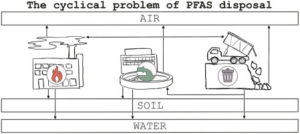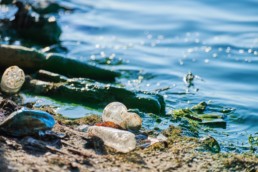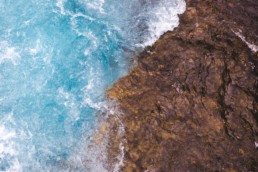Contaminated Landfill Leachate Released into Water Treatment Plants and the Environment
Contaminated Landfill Leachate Released into Wastewater Treatment Plants and the Environment
Landfills are thought be the final resting place for solid and liquid waste, but so many people don't realize the hazards that can still come from that waste. When water runs through the waste in a landfill it produces leachate, a liquid waste that contains a mixture of contaminants from the waste that is has passed through.
The USGS (US Geological Survey) conducted a 2015 study focusing on contaminants of emerging concern in landfill leachate in the U.S. As a result of their research, "Scientists determined that final leachate samples contained 101 of the 190 chemicals analyzed for the study, with chemicals present in every final leachate sample collected at levels ranging from as low as 2 nanograms per liter (ng/L) to as high as 17,200,000 ng/L".
Here's what was said about the purpose of the study: "This research is part of continuing USGS efforts to quantify the contribution of contaminants in leachate released from landfills to various pathways that ultimately lead to the environment. Use of landfills as a means of waste disposal will likely increase as the global population continues to increase... The study is intended to inform landfill managers, stakeholders, and regulators about chemicals present in landfill leachate disposed offsite to environmental pathways".
For the full USGS article on the study, read here.
We applaud the USGS for raising awareness to the fact that landfills are only one step in the cycle of water pollution. To protect our water and our environment, we need to eliminate hazardous waste, not just dump it.
PFAS Can Come From Food As Well As Water
PFAS Can Come From Food As Well As Water
Whereas we primarily here about PFAS contaminating drinking water, it's also know that PFAS travel up food chains. When contaminated water is drank by animals or absorbed by plants, that contamination is then ingested by humans that may eat them.
Greg Barnes reported on an interesting study done researching PFAS in the Yadkin-Pee Dee River in North Carolina. "During a study that began in 2015, the researchers found PFAS in every step of the food chain, from water and sediment to algae, plants, insects, crayfish, mollusks and fish. The researchers also found that the higher up the food chain they looked, the greater the concentration of PFAS."
To read the entire article, click here.
PFAS Found in Highest Altitude Samples on Mt. Everest
PFAS Found in Highest Altitude Samples on Mt. Everest
Because “forever chemicals” are all human made, it’s easy to believe that their reach would only extend to areas where humans frequent. However, even some of the most remote locations on the planet aren’t safe from PFAS contamination, as "forever chemicals" have reached Mt. Everest.
In a 2020 study, called Deposition of PFAS ‘forever chemicals’ on Mt. Everest, PFAS were found in snow and meltwater on from below the Base Camp to the Balcony on Mt. Everest. "Mt. Everest, one of the most coveted climbing mountains on earth, also contains the highest altitude chemical contamination on land. For the first time, meltwater and snow samples from Mt. Everest's Khumbu Glacier were analyzed for “forever chemicals” per- and polyfluoroalkyl substances (PFAS)...The highest concentrations found were 26.14 ng/L and 10.34 ng/L PFOS at Base Camp and Camp 2, respectively. However, PFAS species were seen within 1–2 orders of magnitude in all sampling sites with detection, potentially suggesting a widespread presence on the mountain. Our samples are the highest altitude PFAS samples ever retrieved and indicate the need for further sampling both on Mt. Everest and in the below-glacier watershed".
The graph below is from the study and shows which type of PFAS were found at each sampling site.

For the full research study, click here.
Polar Bears Aren't Safe from PFAS Contamination
Polar Bears Aren't Safe from PFAS Contamination
As they are man made chemicals, one might be quick to assume that PFAS contamination is limited to populated areas, where wildlife constantly interacts with human influence. Unfortunately, that's far from the case as it's been found that PFAS have effected life in the Arctic Ocean. These "forever chemicals" often travel through water, meaning they are part of the water cycle. Contaminated water leaks into the ocean affecting plants and fish. Those fish are eaten by seals, and the seals are eaten by polars bears.
An article from the Chemical Watch website outlines a study done on polar bears in the Barents Sea, stating that "Polar bears that hunt furthest north in the Barents Sea area – part of the Arctic Ocean – have 30-35% higher concentration of perfluoroalkyl substances (PFASs) in their blood compared with coastal bears... One reason for higher levels of PFASs among the eastwards long-walking polar bears, the researchers said, could be that the longer they walk the more energy they need. This makes them eat more seals, which have high concentration of toxins".
Read the full Chemical Watch article here.
The study is simply proof that there is no escaping these "forever chemicals" and of just how important it is to properly eliminate them.
Treating Waste Water Doesn't Stop Chemicals from Contaminating Ground Water
Treating Waste Water Doesn't Stop Chemicals from Contaminating Ground Water
Most wastewater treatment plants now use filters to separate "forever chemicals" out of drinking water, but don't have the means to permanently eliminate them. This means they are still present when the sludge that has been filtered out of the water has been disposed of. The waste water that remains often flows into creeks and streams to groundwater.
USGS scientists conducted a study on pharmaceuticals and other contaminants in treated wastewater effluent at Fourmile Creek, a wastewater-dominated stream near Des Moines, Iowa. "Wastewater effluent contributed approximately 99 and 71 percent of the flow in Fourmile Creek during these sampling periods, respectively... Both stream and shallow groundwater samples were collected during October and December 2012 and analyzed for 110 pharmaceuticals... Analysis of stream-water samples collected downstream of wastewater effluent discharge revealed that 43 percent and 55 percent of pharmaceuticals analyzed were detected in October and December, respectively... 16 percent and 6 percent were detected [in shallow groundwater] during October and December, respectively, at a distance of 20 meters from the stream bank."
Although the study was primarily to test for pharmaceuticals, it was stated that "Other mobile chemicals found in wastewater are expected to have similar fates".
For the whole study, read here.
Current Disposal of PFAS Chemicals Actually Increases Contamintation
Current Disposal of PFAS Chemicals Actually Increases Contamination
With no way of destroying PFAS chemicals, current disposal methods simply move them from one place to another, adding to the cycle of contamination.
In her article from Environmental Working Group reviewing one PFAS study, Monica Amarelo said, "With current disposal options, the concentrated PFAS likely returns to the environment, to require removal once more. As the need to dispose of this waste grows, handling of PFAS waste at disposal sites has received more scrutiny".
The Environmental Working Group is a great resource to expand your PFAS knowledge.
Read Monica's full article here.






